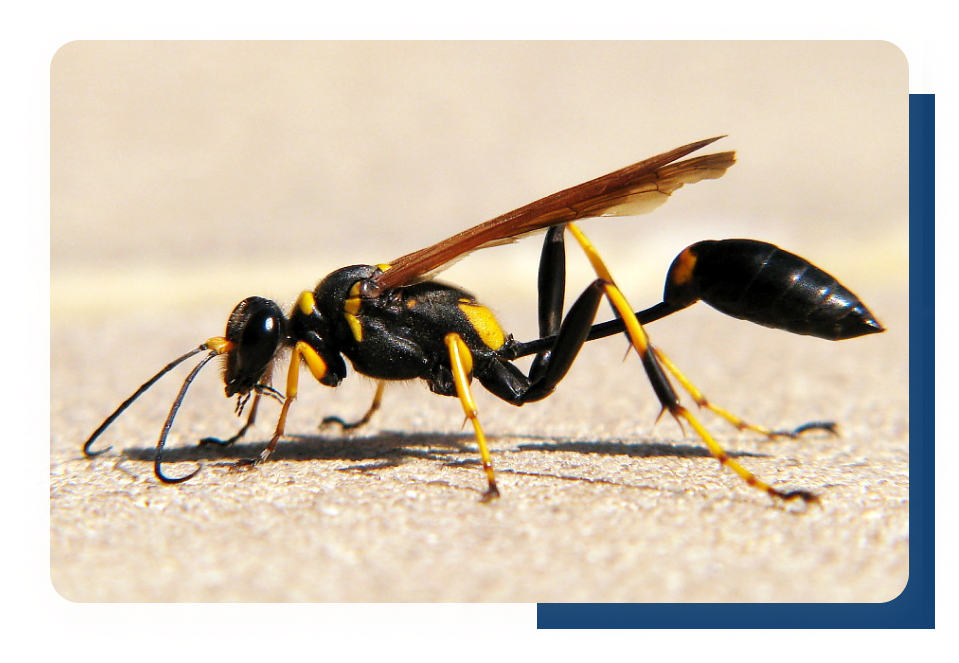
Solitary Wasps with a Messy Reputation
Mud daubers are solitary wasps best known for their distinctive, tube-shaped mud nests. While not aggressive like hornets or yellowjackets, they often build nests on homes, sheds, garages, and attics—leaving behind mud stains, structural blemishes, and in some cases, attracting more aggressive stinging pests. At Blackwood Pest Solutions, we safely remove mud dauber nests, clean the affected areas, and apply preventive treatments to keep your property clean and protected.
What Are Mud Daubers?
Mud daubers are slender wasps with long, narrow “waists,” typically black or metallic blue in color. Unlike social wasps, they live and work alone, rarely sting, and do not aggressively defend their nests. Adults feed on nectar, while their larvae are fed paralyzed spiders that are sealed inside mud chambers built by the female.
Common Types of Mud Daubers
Only a few species are commonly found around homes and structures. Here are the two you’re most likely to encounter:
Black and Yellow Mud Dauber (Sceliphron caementarium)
- Appearance: Black with yellow legs and markings
- Nests: Smooth, tube-like mud structures often found under eaves or on walls
- Prey: Hunts spiders, including black widows, to feed its larvae
- Behavior: Non-aggressive, but nests can accumulate and leave visible damage
Blue Mud Dauber (Chalybion californicum)
- Appearance: Metallic blue with a sleek, shiny body
- Nests: Doesn’t build its own—reuses old nests from other mud dauber species
- Prey: Specializes in hunting black widow spiders
- Behavior: Often seen inspecting surfaces or hovering near existing nests
Where They Nest
Mud daubers prefer dry, sheltered areas where their nests are unlikely to be disturbed. Common nesting sites include:
- Under eaves, decks, and porches
- Inside garages, barns, attics, and sheds
- Along ceilings, rafters, or less-used corners
- Around light fixtures, piping, or exterior stucco
Each nest may include several chambers, and over time, multiple nests can form in the same area.
Are Mud Daubers Dangerous?
Generally, mud daubers are not aggressive and rarely sting. However, they can still pose problems:
- Old nests may attract more aggressive wasps
- Mud buildup can stain or damage siding, paint, and stucco
- Presence near doorways may cause concern or risk for allergic individuals
Signs of Mud Dauber Activity
- Mud tube nests on walls, ceilings, or eaves
- Solitary wasps hovering near shaded, sheltered spots
- Tiny exit holes in old nests (a sign of adult emergence)
- Mud staining or deterioration around nest sites
Prevention Tips
- Seal cracks and entry points along rooflines and exterior walls
- Keep garages, sheds, and attics sealed and free of clutter
- Remove old nests promptly to prevent reuse
- Reduce spider populations around your property
- Limit outdoor lighting that attracts flying insects
Our Mud Dauber Control Approach
Mud daubers are less aggressive than other wasps but can still create unsightly nests and attract more problematic pests if left untreated. At Blackwood Pest Solutions, we begin with a thorough inspection of your property to identify active and abandoned nests, especially in sheltered areas like eaves, garages, and attics. Our technicians use safe, EPA-registered treatments and precision tools to remove existing mud nests without damaging surfaces. We also implement exclusion techniques to prevent future nesting, sealing off common entry points and offering maintenance plans when needed. Our goal is to keep your property clean, safe, and mud-dauber-free year-round.
Get In Touch



